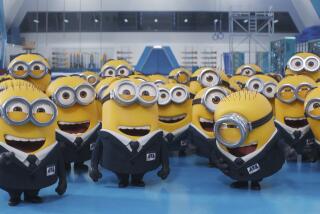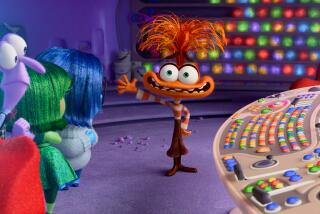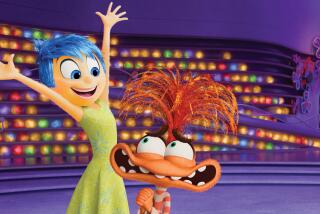How Pixar put a fresh set of tires on one of its most valuable franchises with ‘Cars 3’
In Hollywood, as it is everywhere, no one escapes from the ravages of time. Not the beautiful people who walk the red carpets. Not the power players who pull the strings in the executive suites.
And evidently not even the animated talking cars.
In Disney/Pixar’s “Cars 3,” in theaters Friday, the hard-charging race car Lightning McQueen (voiced by Owen Wilson) finds himself grappling with the automotive version of a midlife crisis, as a younger, faster car named Jackson Storm (Armie Hammer) emerges on the racing scene and threatens to force him into involuntary retirement. With the help of a plucky, tech-savvy young trainer named Cruz Ramirez (Cristela Alonzo), Lightning tries to get his mojo back.
Middle-age angst may seem like an unusual plot driver for a kids’ movie whose core audience is still in elementary school. Even Wilson admits it took him by surprise at first.
“I was like, ‘Wow, even my animated characters — they’re making them get older?’ ” the actor, who is 49, says with a laugh. “I’m aware that, as an actor, you’re probably not doing romantic comedies or buddy comedies as much in your late 40s as you would in your early 30s. But I thought this one was kind of safe.”
With the “Cars” franchise itself now over a decade old, though, this grown-up-oriented story line offers a way for the series to appeal to both parents and to the kids who fell in love with the first “Cars” movie back in 2006, many of whom are now approaching adulthood themselves. At the same time, Pixar and Disney are working hard to cultivate a new generation of “Cars” fans – and, in particular, bring more young girls into the fold with the introduction of a major female character in Cruz.
Pixar has never shied away from incorporating grown-up themes into its films, of course, whether it’s the fear of mortality in “Toy Story 3,” parental anxiety in “Finding Nemo” or environmental destruction in “Wall-E.” Indeed, the animation studio plumbed the indignities of middle age once before in its 2004 film “The Incredibles,” which centers on a pair of married superheroes in the suburbs trying to adjust to the sometimes spirit-crushing struggles of work and parenting.
“We really don’t make our movies for a particular age group or gender — we truly make them for everybody,” says John Lasseter, chief executive of Pixar Animation Studios and Walt Disney Animation Studios, who directed the first two “Cars” films. “If someone is breathing, they’re our target. That’s my philosophy.”
Lasseter says the initial inspiration for McQueen’s emotional journey in “Cars 3” — which sees him transition from hotshot racing champion to elder statesman and mentor — came from his friendship with NASCAR racer Jeff Gordon, who announced his retirement from the sport in 2015 at age 43.
“In the last few years of his racing career, Jeff would talk to me a lot about the young drivers coming in,” Lasseter says. “There was this energy they had and he realized, ‘That’s the way I was when I was younger.’ I started thinking, ‘Well, that could be where Lightning McQueen is at.’ ”
That said, “Cars” has proven a particularly potent series with very young kids and, as “Cars 3” director Brian Fee acknowledges, kids don’t, as a general rule, suffer from midlife crises.
“Hopefully they don’t,” Fee, who is making his feature directorial debut, says with a laugh. “But while kids don’t understand midlife crisis, they do understand that McQueen can’t race anymore. They do understand the thing they want to see, the thing that makes their favorite character happy, is something that he can’t do anymore.”
The power of the franchise’s appeal to young kids — and especially boys — is evidenced by the merchandising bonanza it has spawned over the years, which rivals those of juggernauts like “Harry Potter,” “Star Wars” and Pixar’s own “Toy Story.”
Though the first two “Cars” films are only the 10th and 15th highest-grossing Pixar movies at the domestic box office, respectively, and have not been as widely embraced by critics as many of the animation studio’s other films, they have powered a booming industry in everything from “Cars”-branded toys to school supplies to apparel to bedding to video games.
In just the first five years after the release of “Cars,” the franchise generated $10 billion in global retail sales. In 2012, Disney opened Cars Land at its California Adventure theme park to further capitalize on the appetite for all things “Cars.”
But while a beast of that size clearly needs to be continually fed, Fee says he did his best to tune it out while making the film.
If any kid is carrying around a backpack or holding a toy, that’s hopefully because they like the story and the characters — not the other way around.
— Brian Fee
“I don’t think or care about merchandise,” he says. “The thing is, if we make a good film, that machine will have whatever it needs to keep going. But it’s all about the movie for me. If any kid is carrying around a backpack or holding a toy, that’s hopefully because they like the story and the characters — not the other way around.”
“John Lasseter loves all the toys, all the merchandise — he’s such a perfectionist about making sure they’re the best and coolest products possible,” says “Cars 3” producer Kevin Reher. “But it’s Brian’s job to tell the story.”
Though Lasseter himself has had a deep passion for cars since boyhood, he says that from the earliest days of the “Cars” franchise he tried to make something that could appeal to anyone, regardless of their level of interest in cars or their gender.
“When I was working on the first one, my wife, Nancy, said, ‘You can’t make this movie just for yourself and your car-geek buddies — you’ve got to make it for me and your nieces and people who aren’t into cars,’ ” he recalls. “Through the whole first movie, it became what was known as ‘the Nancy factor.’ There are young boys that really love Lightning McQueen, but there are a lot of girls that love him, too. It was a conscious decision to make him red — it’s not the typically quote-unquote ‘boy color.’ ”
With the introduction of Cruz Ramirez, Pixar is clearly hoping to rev up the series’ appeal to girls a few more notches. In advance of the movie’s release, Disney’s online store has been stocked with T-shirts for girls and women emblazoned with the character’s name and the words “My Way or the Highway.”
Fee says he hopes the character — who set aside her racing ambitions because she didn’t see any other female cars on the track — will inspire young girls like his own two daughters to not hold themselves back from pursuing their dreams.
“I’m really hoping kids see themselves in Cruz,” Fee says. “My daughters didn’t want to learn to play guitar because they decided guitar is just a boys’ thing. That broke my heart for them to say that. I’d sometimes watch them be afraid to try things because they didn’t want to fail. We hope Cruz speaks for people that have felt out of place, because I think that’s everybody more often than they’d probably admit.”
With an “Incredibles” sequel and a fourth “Toy Story” film already in the Pixar pipeline, Lasseter suggests that the “Cars” franchise could still have more gas left in its tank. But for now he isn’t getting ahead of himself.
“I love these characters and I love the world and there are so many other stories that you could tell,” he says. “But we don’t decide that we’re going to do it until we have a story that we think would make a great movie.”
On some level, of course, the future of the “Cars” franchise is not entirely up to Pixar and Disney – the audience will ultimately determine how many miles end up on the odometer. To the question of how one knows when it’s time to stop and retire, one character in “Cars 3” offers a blunt answer: “The youngsters will tell you.”
Twitter: @joshrottenberg
More to Read
Only good movies
Get the Indie Focus newsletter, Mark Olsen's weekly guide to the world of cinema.
You may occasionally receive promotional content from the Los Angeles Times.











